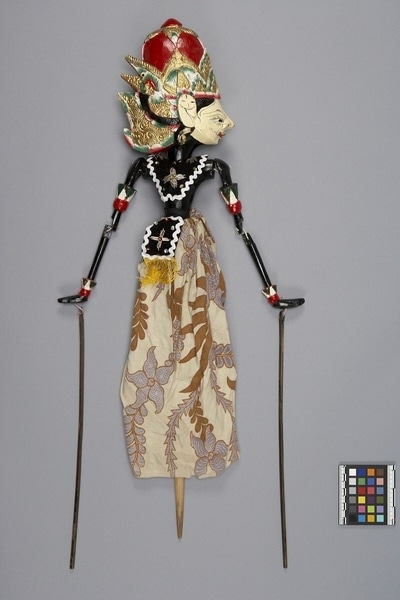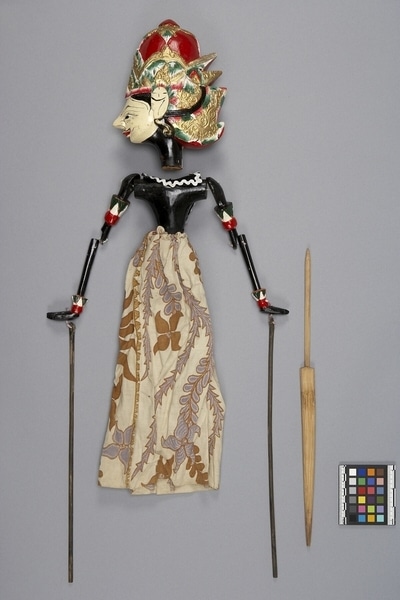Rod Puppet Item Number: Ib407 a-c from the MOA: University of British Columbia


Description
Three-dimensional male human figure; large head and jointed arms attached to controlling rods. Head with straight, pointed nose positioned forward; cream-coloured face, white eyes with black pupils, and red lips. Features very delicate, and outlined in black: small black moustache and beard. Wide red crown (mahkota) headdress with green, gold, white, and red diadem, karawista, and Garuda Mungkur. Black hair, curled with gold highlights. Upper torso and neck coloured black. Black chest covering and apron with white wavy trim; also sequins and twisted wire decorations. Apron has waistband and yellow fringe at bottom. Beige, brown, and purple coloured batik skirt (kain). Arms have a pair of red and green ornaments at wrists and biceps. Hands are held flat and bent back at wrists.
History Of Use
Javanese puppetry as an art form probably developed by the 11th century. Wayang golek puppets of western Java appeared during the 16th century. Originally the plays depicted Javanese mythology, but after the Indian conquest of Java the Hindu epics, Ramayana and Mahabharata, were incorporated into the cycles, which comprise about 200 plays. A dalang (puppet master) performs the plays to celebrate important occasions, usually in three acts, with vocal and instrumental accompaniment. Typically they serve a moral and religious purpose, and more recently, one of political commentary. Kresna is the king (prabu) of Dwawarati in the Mahabharata cycle. He is an incarnation of Vishnu. Kresna is a special ally of the Pandawa brothers, particularly Arjuna.
Iconographic Meaning
Each puppet is characterized by its wanda, a Javanese word which describes the specific mixture of elements of size, form, colour, ornamentation and carving. Position and colour of face suggest some virtue. Small features are refined. Position of hands, arm ornaments, batik skirt, and particularly crown indicate very high nobility (king or god). Not positively identified; likely a variation of Kresna.
Cultural Context
Theatrical performance.
Item History
- Made in Java, Indonesia
- Owned by Donald Bone before January 4, 1980
- Received from Donald Bone (Seller) and Museum of Anthropology Donations Fund (Funding source) on January 4, 1980
What
- Name
- Rod Puppet
- Identification Number
- Ib407 a-c
- Type of Item
- puppet
- Material
- wood, fibre, paint and cotton fibre
- Manufacturing Technique
- carved, sewn, painted, woven and tied
- Part B
- height 23.0 cm, width 17.0 cm, depth 6.7 cm
- Part C
- height 42.0 cm, width 3.0 cm, depth 0.8 cm
- Part A
- height 62.0 cm, width 14.0 cm, depth 6.0 cm
Who
- Culture
- Sundanese
- Previous Owner
- Donald Bone
- Received from
- Donald Bone (Seller) and Museum of Anthropology Donations Fund (Funding source)
Where
- Holding Institution
- MOA: University of British Columbia
- Made in
- Java, Indonesia
When
- Ownership Date
- before January 4, 1980
- Acquisition Date
- on January 4, 1980
Other
- Condition
- good
- Accession Number
- 0586/0027 a-c